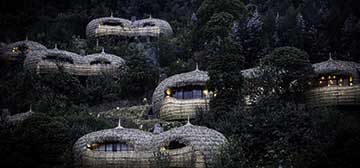
Bisate Lodge
- Volcanoes National Park, RwandaBisate Lodge has dramatic views of the peaks of the volcanoes Bisoke and Karisimbi rearing up through the Afro-alpine forests of nearby Volcanoes National Park.

Rwanda, a tiny landlocked country in central Africa, is characterised by undulating hilly and mountainous terrain and is known as the “Land of a Thousand Hills.” Situated in the heart of the Albertine Rift, it is one of Africa’s most biodiverse regions, a haven of rainforest endemism with its most celebrated wild mammal being the iconic mountain gorilla of the Virunga massif.
A densely-populated country with a predominantly rural population, Rwanda is known for its traumatic history in the form of the 1994 genocide, as well as for its courageous recovery to become a stable, well-run and united country. Such optimistic energy has earned the country the epithet “Remarkable Rwanda” and a fast-growing number of curious tourists and fans.
Things to look forward to in Rwanda:Rwanda’s terrain is defined by undulating hills and mountains, with rainforest on the western heights and cultivated fields in the valleys below. From the central parts, the land slopes away to the savannahs and marshes of the east. The Virunga massif is home to volcanoes and swathes of rainforest, while nearby lies huge Lake Kivu. Many lakes and marshes intersected by clay-based savannah are found in the east. Lying to the south of Volcanoes National Park, Gishwati-Mukura National Park and Nyungwe Forest National Park are home to a vast and diverse number of primate and other animal and bird species. It is here that partially-habituated chimpanzees are found.
Volcanoes National Park (16 000 hectares / 40 000 acres) is part of a 44 800-hectare (110 000-acre) conservation area that is a World Heritage Site and home to some 480 mountain gorillas, amongst a host of other rainforest species.
The Albertine Rift is perhaps the richest location in Africa for both mammal and bird diversity, and mammal and bird endemism. It is also one of three locations in Africa most important for primate diversity and conservation.
Aside from more than a thousand plant species, 670 bird species and myriad reptiles and amphibians, Rwanda boasts some 151 mammal species, amongst which are 15 primates – including one of our closest genetic relatives and the famous subjects of Dian Fossey’s seminal research – the mountain gorillas.
North West Rwanda has two rainy periods; from about March to May and then again over October and November. Although around the Volcanoes National Park rain can fall at any time of the year (and often does), it is these two periods when rain can be expected and when it does, it falls in relatively heavy downpours, usually occurring in the afternoons. The landscapes are lush and green, and the air clear of the haze that can characterise the drier periods, making for ideal photographic conditions. Gorilla viewing is just as good now as at any other time of the year, but don’t forget to bring your wet-weather gear.
During the two seasonal dry periods in North West Rwanda day time temperatures can be warm and sunshine bright. While rainfall is not common it is possible at any time of the year, although far lighter in nature. The rainfall and the associated cloud cover can help to moderate temperatures.